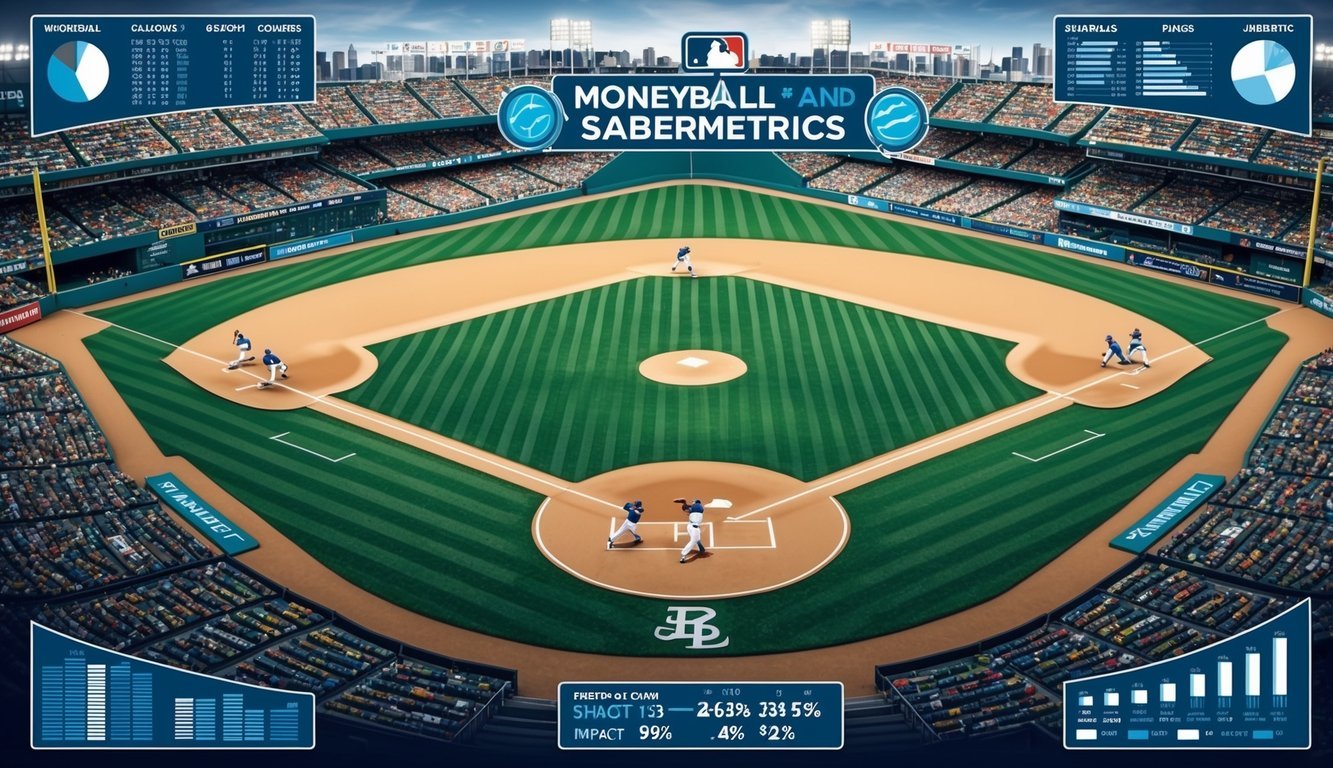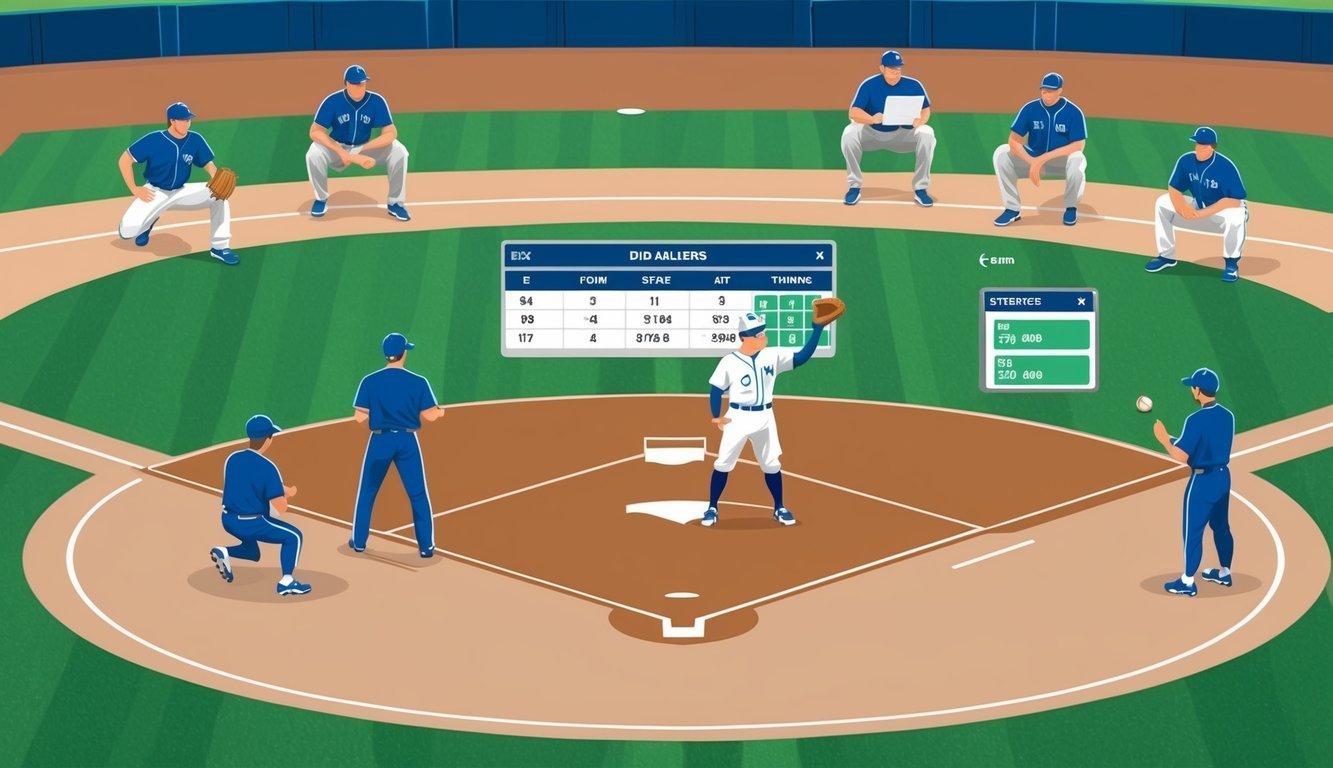The Oakland Athletics embraced sabermetrics in the early 2000s.
This analytical method, popularized by Michael Lewis’s book “Moneyball,” revolutionized how teams evaluate player performance and build rosters.
The Moneyball strategy allowed the Athletics to compete with wealthier teams by using data-driven decisions to identify undervalued players.
The sabermetrics revolution has since spread throughout Major League Baseball.
Teams now employ sophisticated statistical analysis to gain competitive advantages.
This shift has transformed player evaluation, strategy, and even how fans engage with the sport.
Moneyball’s impact extends beyond professional baseball.
Fantasy leagues and online platforms have adopted similar analytical approaches, allowing casual fans to dive deeper into the numbers.
The blend of traditional baseball wisdom with advanced statistics has created a new era of understanding and appreciating America’s pastime.
The Genesis of Moneyball
Moneyball revolutionized baseball by introducing data-driven decision-making to team management.
This approach challenged traditional scouting methods and changed how organizations evaluate players.
Birth of Sabermetrics
Bill James coined the term “sabermetrics” in the 1970s.
He developed new ways to analyze baseball statistics, looking beyond conventional measures like batting average and ERA.
James published his findings in the Baseball Abstract, gaining a dedicated following among stats enthusiasts.
His work laid the foundation for a new way of thinking about player value.
Sabermetrics focused on metrics like on-base percentage and slugging percentage.
These stats provided a more complete picture of a player’s contributions to winning games.
James’ ideas slowly gained traction in baseball circles.
Some teams began incorporating sabermetric principles into their decision-making processes.
However, it would take years for these concepts to fully catch on in Major League Baseball.
Billy Beane and the Oakland Athletics
Billy Beane, general manager of the Oakland Athletics, faced a major challenge in the early 2000s.
His team had one of the lowest payrolls in baseball.
Beane needed a way to compete with richer clubs.
He turned to sabermetrics as a solution.
Beane hired Paul DePodesta, a Harvard graduate with a talent for statistical analysis.
Together, they implemented a data-driven approach to player evaluation and acquisition.
The A’s focused on undervalued skills like drawing walks and getting on base.
They signed players who excelled in these areas but were overlooked by other teams.
This strategy allowed Oakland to build a competitive team on a budget.
Michael Lewis chronicled the A’s 2002 season in his book “Moneyball”.
The book brought widespread attention to Beane’s methods and sabermetrics in general.
It sparked a revolution in how many teams approach player evaluation and team-building.
Sabermetrics in Action
Sabermetrics revolutionized how baseball teams evaluate players and make decisions.
It introduced new ways to measure performance and assess value beyond traditional statistics.
Key Statistics and Metrics
Sabermetrics introduced several innovative statistics that provide deeper insights into player performance.
On-Base Percentage (OBP) measures a player’s ability to reach base, regardless of how they do it.
It’s considered more valuable than batting average alone.
Slugging Percentage (SLG) reflects a batter’s power by measuring total bases per at-bat.
OPS, which combines OBP and SLG, offers a more comprehensive view of a hitter’s offensive contribution.
For pitchers, stats like FIP (Fielding Independent Pitching) aim to isolate a pitcher’s performance from factors outside their control.
These metrics help teams identify undervalued players and make smarter roster decisions.
Assessing Player Value
Wins Above Replacement (WAR) is perhaps the most famous sabermetric stat.
It attempts to capture a player’s total contribution to their team in a single number.
WAR considers offensive and defensive contributions, as well as positional value.
It allows teams to compare players across different positions and eras.
Teams use WAR and other advanced metrics to:
- Evaluate trade opportunities
- Make free agent decisions
- Determine optimal lineup configurations
By focusing on these objective measures, teams can often find hidden gems – players who contribute more to winning than traditional stats suggest.
Impact on Baseball and Beyond

Moneyball’s influence extended far beyond the Oakland A’s, reshaping how teams approach player evaluation and strategy across Major League Baseball and other sports.
Changing the Game
Sabermetrics revolutionized baseball decision-making.
Teams began prioritizing on-base percentage over batting average and valuing previously overlooked skills.
The Boston Red Sox famously adopted these principles, ending their 86-year World Series drought in 2004.
Advanced metrics like WAR (Wins Above Replacement) became crucial in player valuation.
Front offices invested heavily in data analysis departments.
On the field, defensive shifts increased dramatically based on statistical tendencies.
Some traditional baseball minds initially resisted the change.
But as data-driven teams found success, even the most old-school organizations like the New York Yankees embraced analytics to some degree.
Adoption by Other Teams
Moneyball’s success sparked a league-wide analytics arms race.
Small-market teams saw it as a way to compete with big spenders.
The Tampa Bay Rays became masters at finding undervalued talent through data analysis.
By the mid-2010s, every MLB team had a dedicated analytics department.
The Houston Astros took it to the extreme, completely rebuilding their organization around data.
They went from losing 100+ games to winning the World Series in just a few years.
Data now influences everything from draft picks to pitch selection.
Teams use sophisticated tracking systems to measure player movements and ball flight paths.
This wealth of information helps optimize strategies and player development.
Influence on Professional Sports
The Moneyball revolution spread beyond baseball.
NBA teams now prioritize three-pointers based on analytics.
NFL teams make draft and in-game decisions using advanced stats.
Soccer clubs use data to scout players and analyze match performances.
Even individual sports like tennis have embraced analytics for player development and strategy.
The rise of sports betting and fantasy leagues further fueled the demand for advanced stats.
Fans now have access to complex metrics that were once confined to team front offices.
Data analysis has become a crucial skill for aspiring sports executives.
Many MLB general managers now have backgrounds in economics or computer science rather than traditional scouting.
Data-Driven Management

Baseball front offices now rely heavily on statistical analysis to make key decisions.
This shift has transformed how teams operate both on and off the field.
Front Office Strategy
General managers use advanced metrics to evaluate players and construct rosters.
They analyze data on everything from pitch velocities to defensive shifts.
This approach helps teams identify undervalued talent and gain competitive advantages.
Statistical models predict player performance and injury risks.
Front offices use this information to guide contract negotiations and trades.
Data also informs draft strategies, allowing teams to spot promising prospects others might overlook.
Analytics shape in-game tactics too.
Managers receive data-driven insights on lineup optimization and pitching matchups.
This information guides decisions like when to use defensive shifts or attempt stolen bases.
Sabermetric Revolution in the Office
The business side of baseball has embraced analytics as well.
Teams use data to set ticket prices, plan promotions, and improve fan experiences.
Predictive models help forecast attendance and revenue.
Front offices employ statisticians and data scientists to gain edges.
These experts develop proprietary systems to analyze player value and team performance.
Their work influences everything from scouting to stadium operations.
Data-driven approaches have spread to player development.
Minor league affiliates use technology to track prospects’ progress.
This helps teams tailor training programs and make informed promotion decisions.
The Future of Sabermetrics

Sabermetrics continues to evolve, pushing the boundaries of baseball analysis.
New technologies and methodologies are transforming how teams evaluate players and make strategic decisions.
Additionally, the integration of advanced statistics into baseball video games for consoles has made it easier for fans and aspiring analysts to understand complex metrics in a more engaging context.
These games often simulate real-life player performance, allowing users to experiment with various strategies based on the latest sabermetric trends.
As a result, the next generation of players and fans is becoming increasingly equipped to think critically about the game, enhancing their appreciation for both its historical and analytical dimensions.
Integration with AI and Machine Learning
AI and machine learning are revolutionizing sabermetrics.
Teams now use advanced algorithms to process vast amounts of data, uncovering hidden patterns and insights.
These tools help predict player performance with greater accuracy.
Statistical analysts are developing AI models that can analyze video footage in real-time.
These systems track player movements, pitch trajectories, and bat speeds.
The data feeds into complex algorithms, providing coaches with instant strategic recommendations.
Machine learning also enhances player development.
AI-powered systems can identify subtle flaws in a batter’s swing or a pitcher’s delivery.
This allows for personalized training programs tailored to each player’s unique needs.
Evolving Metrics and Models
Sabermetric statistics are becoming increasingly sophisticated.
New metrics go beyond traditional measures like batting average and ERA.
They now account for factors such as exit velocity, launch angle, and spin rate.
Analysts are creating more comprehensive player valuation models.
These models incorporate both on-field performance and off-field factors.
Team chemistry, injury risk, and mental resilience are now quantified and factored into decisions.
Predictive modeling is gaining prominence.
Teams use complex simulations to forecast how players might perform in different scenarios.
This helps with lineup optimization, in-game strategy, and long-term roster planning.
As technology advances, expect even more innovative metrics to emerge.
The goal remains the same: to gain a competitive edge through data-driven insights.
